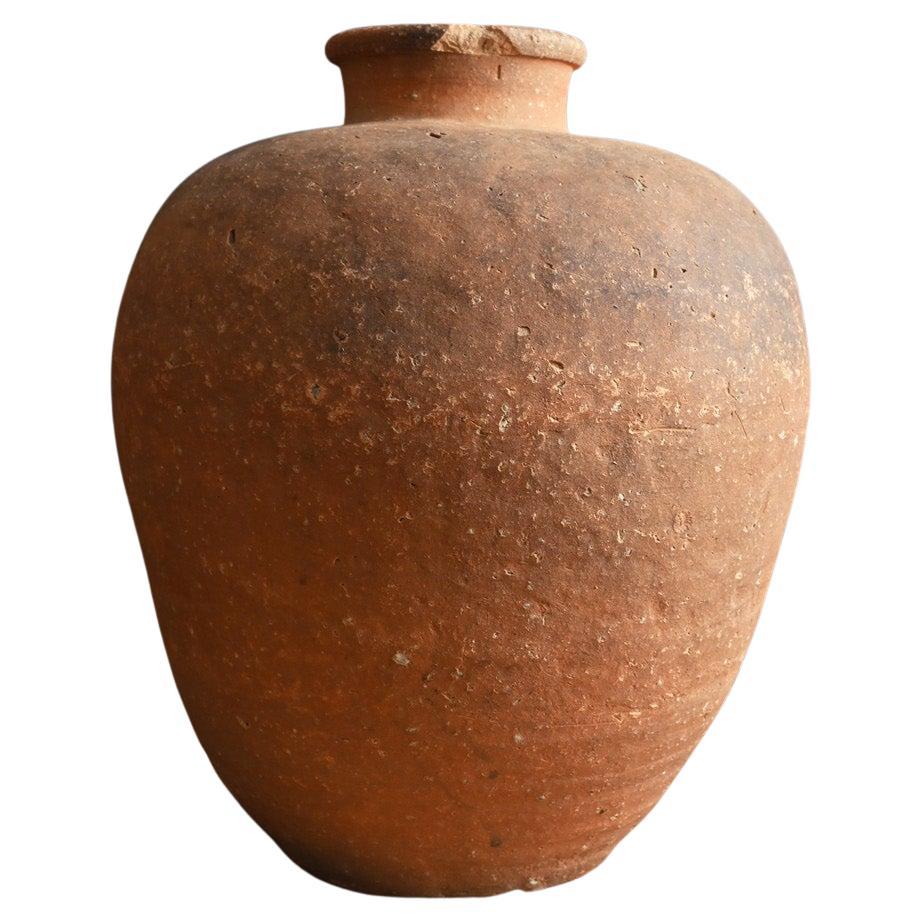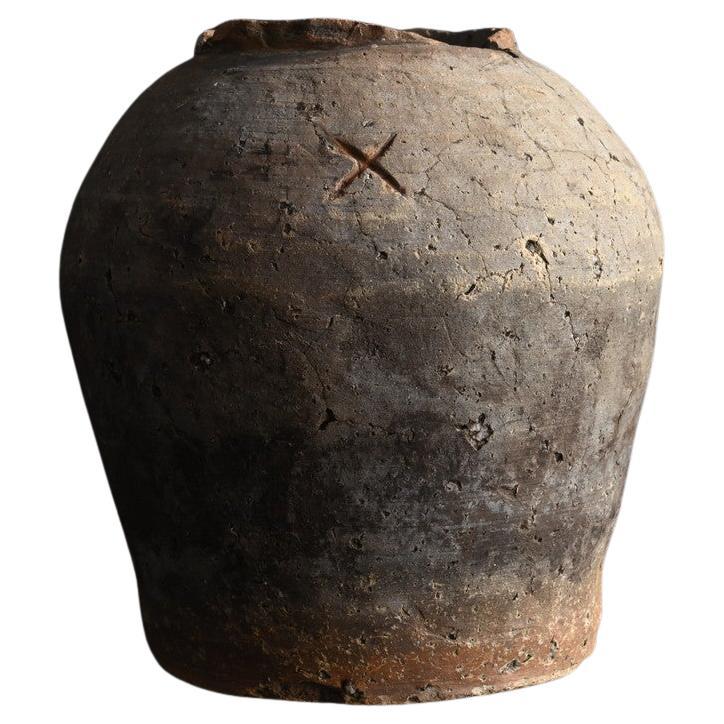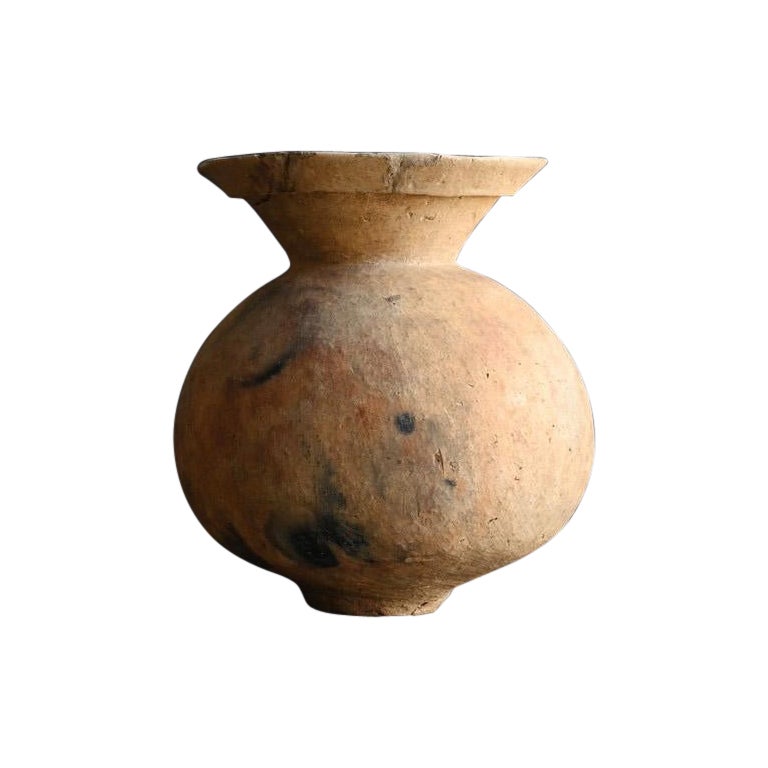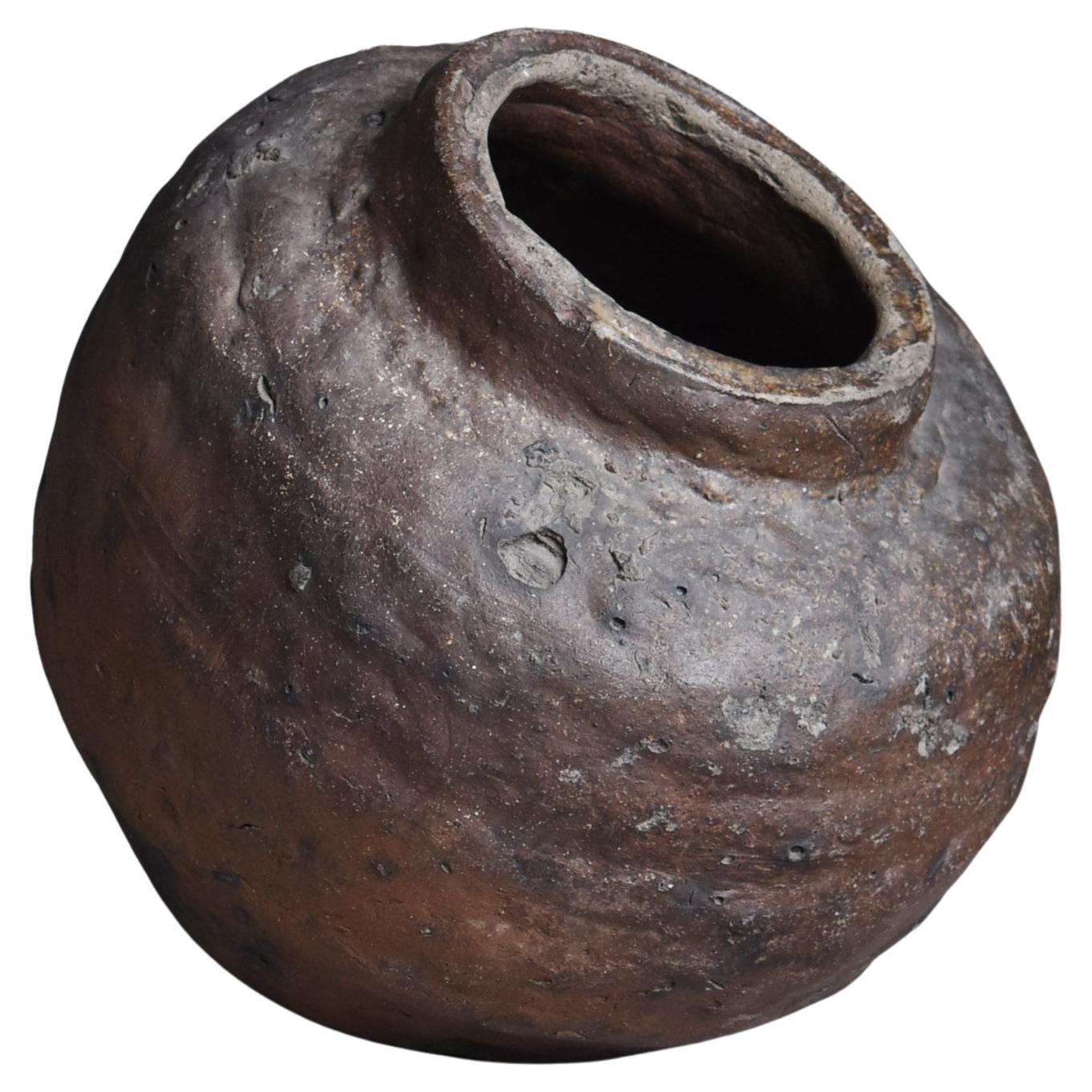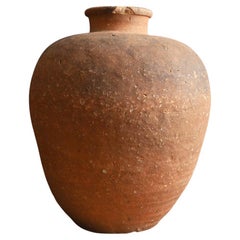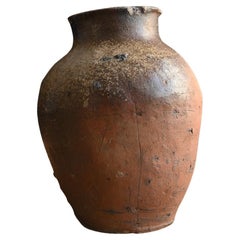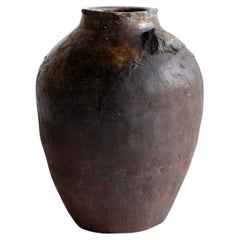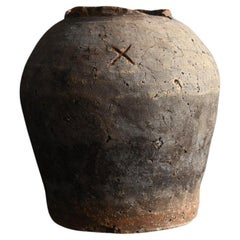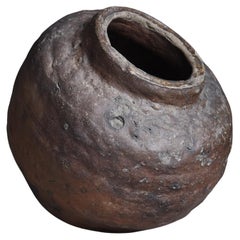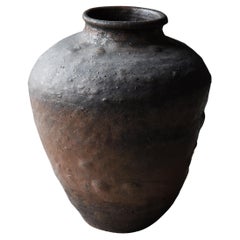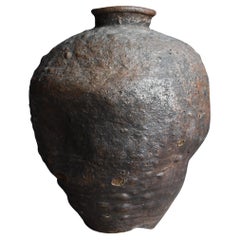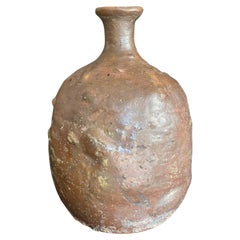Objekte ähnlich wie Japanische antike Shigaraki-Warenvase/1400-1573/Wabi-sabi-Vase aus Japan
Möchten Sie mehr Bilder oder Videos?
Zusätzliche Bilder oder Videos von dem*der Anbieter*in anfordern
1 von 21
Japanische antike Shigaraki-Warenvase/1400-1573/Wabi-sabi-Vase aus Japan
1.746,03 €
Angaben zum Objekt
It is "Shigaraki ware".
Shigaraki ware is a historic kiln located in Shiga Prefecture.
(The Shigaraki ware kiln is circled in red in the image.)
It is said to have originated in the 8th century.
There are six kilns with long histories in Japan,
and this is one of them.
This jar was fired in the Muromachi period (1400s), which is even older than the Edo period.
Shigaraki ware is characterized by its abundance of feldspar (glassy pebbles).
Small grains can be seen on the surface of the jar, which are feldspar.
The pebbles that look like they have broken through the jar's skin are also feldspar.
The characteristics of this jar are well displayed.
And the greatest attraction of this jar is the beautiful finish it has after firing.
The appearance of the jar changes greatly depending on the temperature and heat of the kiln.
It is impressive as it produces a gradation of various colors.
It does not have the same appearance from any angle, 360 degrees.
I think it is a masterpiece among Shigaraki ware jars.
Another interesting point is that this jar usually has a trumpet-like tip, but it was intentionally broken like this.
Old Shigaraki ware jars are often found in this state, and it is thought that the tip was broken to make it easier to use as a tool.
I think this shape is also beautiful.
Also, as a reference, a similar item from the same era as this item was featured in the Japanese art book "Shigaraki Ware Masterpieces Illustrated Guide," so I have attached a photo of it.
Also, the side of this jar that was exposed to the strong heat has a lot of ash on it, and there are traces of natural glaze flow.
The most interesting part is the cracked part.
It is thought to have broken while it was being fired in the kiln.
This is a product of chance.
In Japanese, a jar that looks like torn paper like this is called a "Yabure Tsubo." "Yabure" = torn, "Tsubo" = jar
A jar in this state is very rare.
It is difficult to get one even in Japan.
Also, the part circled in red is probably cracked when it was knocked over.
However, it is glued together so you can use it without any problems.
There is also a thin crack at the bottom, so if you put water in it, it may leak out.
If you want to decorate it with flowers, fill another container with water and put it in this vase.
This item was owned by a Japanese collector.
Why not show it off to your friends?
This vase is recommended!
Weight: 6.3kg
[We have a unique Japanese aesthetic sense.
And only we can introduce unique items through our purchasing channels in Japan and the experience we have gained so far, in such a way that no one else can imitate.]
- Maße:Höhe: 35,2 cm (13,86 in)Durchmesser: 31,6 cm (12,45 in)
- Stil:Sonstiges (Aus dem Zeitalter)
- Materialien und Methoden:
- Herkunftsort:
- Zeitalter:
- Herstellungsjahr:1400-1573
- Zustand:Repariert: the part circled in red is probably cracked when it was knocked over. However, it is glued together so you can use it without any problems. There is also a thin crack at the bottom, so if you put water in it, it may leak out.
- Anbieterstandort:Sammu-shi, JP
- Referenznummer:1stDibs: LU5487242445002
Anbieterinformationen
5,0
Platin-Anbieter*in
Premium-Anbieter*innen mit einer Bewertung über 4,7 und 24 Stunden Reaktionszeit
Gründungsjahr 2015
1stDibs-Anbieter*in seit 2020
1.612 Verkäufe auf 1stDibs
Typische Antwortzeit: 6 Stunde
- VersandAngebot wird abgerufen …Versand von: senzoku, Japan
- Rückgabebedingungen
Einige Inhalte dieser Seite wurden automatisch übersetzt. Daher kann 1stDibs nicht die Richtigkeit der Übersetzungen garantieren. Englisch ist die Standardsprache dieser Website.
Authentizitätsgarantie
Im unwahrscheinlichen Fall eines Problems mit der Echtheit eines Objekts kontaktieren Sie uns bitte innerhalb von 1 Jahr für eine volle Rückerstattung. DetailsGeld-Zurück-Garantie
Wenn Ihr Objekt nicht der Beschreibung entspricht, beim Transport beschädigt wurde oder nicht ankommt, kontaktieren Sie uns bitte innerhalb von 7 Tagen für eine vollständige Rückerstattung. DetailsStornierung innerhalb von 24 Stunden
Sie können Ihren Kauf jederzeit innerhalb von 24 Stunden stornieren, ohne jegliche Gründe dafür angeben zu müssen.Geprüfte Anbieter*innen
Unsere Anbieter*innen unterliegen strengen Dienstleistungs- und Qualitätsstandards, wodurch wir die Seriosität unserer Angebote gewährleisten können.Preisgarantie
Wenn Sie feststellen, dass ein*e Anbieter*in dasselbe Objekt anderswo zu einem niedrigeren Preis anbietet, werden wir den Preis entsprechend anpassen.Zuverlässige weltweite Lieferung
Unsere erstklassigen Versandunternehmen bieten spezielle Versandoptionen weltweit, einschließlich individueller Lieferung.Mehr von diesem*dieser Anbieter*in
Alle anzeigenJapanische antike Shigaraki-Warenvase/Vase mit geriffeltem Wabi-sabi-Muster/16. Jahrhundert
Dies ist Shigaraki-Töpferware aus der Präfektur Shiga, Japan. Die Shigaraki-Ware soll um das 8. Jahrhundert in der Region Shigaraki in der Präfektur Shiga entstanden sein und ist ein...
Kategorie
Antik, 15. Jahrhundert und früher, Japanisch, Sonstiges, Gefäße
Materialien
Töpferwaren
Japanisches antikes japanisches Keramikgefäß aus dem 15. bis 16. Jahrhundert/ Wabi-Sabi-Gefäß/Tokoname-Vase
Es ist ein sehr altes Gefäß in Japan.
Dies ist eine Töpferei namens Tokoname ware.
Tokoname ist ein Brennofen in der Präfektur Aichi, Japan.
Es soll um das 12. Jahrhundert herum ents...
Kategorie
Antik, 16. Jahrhundert, Japanisch, Sonstiges, Vasen
Materialien
Töpferwaren
Japanisches antikes japanisches Keramikgefäß aus dem 16.-17. Jahrhundert/ Wabi-Sabi-Vase/Tokoname
Tokoname ist eine Region in der Präfektur Aichi.
Es ist ein Zentrum der Töpferwarenherstellung mit einer sehr alten Geschichte in Japan (um das 12. Jahrhundert).
Diese Krüge wurden ...
Kategorie
Antik, Anfang des 17. Jahrhunderts, Japanisch, Edo, Vasen
Materialien
Töpferwaren
Antike japanische Keramikvase/14. bis 15. Jahrhundert/„Shigaraki-Ware“
Es handelt sich um "Shigaraki-Ware".
Shigaraki ist ein historischer Brennofen in der Präfektur Shiga, Japan. (Shigaraki Kiln ist auf der Karte mit einem roten Kreis markiert).
Man sa...
Kategorie
Antik, 15. Jahrhundert und früher, Japanisch, Sonstiges, Gefäße
Materialien
Töpferwaren
Sehr alte japanische Vase aus ausgegrabenem Steingut/Wabi Sabi-Vase
Dies ist Steingut, das in Japan ausgegraben wurde.
Er hat eine sehr schöne Form und ist gut ausbalanciert.
Die Farbe der Töpferware ist hellbraun, da sie bei niedriger Temperatur geb...
Kategorie
Antik, 15. Jahrhundert und früher, Japanisch, Sonstiges, Vasen
Materialien
Töpferwaren
Japanisches antikes japanisches Keramikgefäß aus dem 16.-17. Jahrhundert/ Wabi-Sabi-Vase/Tokoname
Tokoname ist eine Region in der Präfektur Aichi.
Es ist ein Zentrum der Töpferwarenherstellung mit einer sehr alten Geschichte in Japan (um das 12. Jahrhundert).
Diese Krüge wurden ...
Kategorie
Antik, Anfang des 17. Jahrhunderts, Japanisch, Edo, Vasen
Materialien
Töpferwaren
Das könnte Ihnen auch gefallen
Japanische japanische „Lying Bizen ware“-Keramikvase Wabi Sabi, 18. Jahrhundert
Dies ist eine japanische Bizen-Ware. Sie wird Ko-Bizen genannt.
Man schätzt, dass sie in der Edo-Zeit (18. Jahrhundert) hergestellt wurde, und sie hat eine sehr starke Ausstrahlung.
...
Kategorie
Antik, 18. Jahrhundert, Japanisch, Edo, Vasen
Materialien
Töpferwaren
Japanische japanische „Shigaraki“-Vase/Keramikvase/Gefäß Wabi Sabi, 17. Jahrhundert
Dies ist ein in Japan hergestelltes Keramikgefäß.
Sie stammt aus dem 17. Jahrhundert und ist ein wertvolles Stück, das den Lebensstil und das ästhetische Empfinden der damaligen Zeit...
Kategorie
Antik, 17. Jahrhundert, Japanisch, Edo, Vasen
Materialien
Töpferwaren
Japanese Antique Shigaraki ware 17th Century / Pottery Vase Wabisabi
This is an old pottery pot made in Japan.
It is a very old pot believed to have been made in the 17th century, early Edo period, and is called Koshigaraki in Japan.
Koshigaraki refe...
Kategorie
Antik, 17. Jahrhundert, Japanisch, Edo, Vasen
Materialien
Töpferwaren
Antike japanische Edo Meiji Wabi-Sabi Tanba Tamba-Kunstkeramik-Vase/Keramik-Topf/ Topf, Edo Meiji
Eine wunderschön geformte, glasierte (eine Lavakraterglasur, die an moderne westliche Töpferinnen wie Beatrice Wood, Glenn Lukens und Otto und Gertrud Natzler erinnert) und komplex s...
Kategorie
Antik, Spätes 19. Jahrhundert, Japanisch, Meiji-Periode, Tonwaren
Materialien
Tonware, Töpferwaren
Japanische antike Shigaraki Ware 18. Jahrhundert / Keramik Vase Wabi Sabi
Dies ist ein alter, großer Shigaraki-Topf, der in Japan hergestellt wurde.
Man schätzt, dass sie in der späten Edo-Periode, etwa im 18. Jahrhundert, hergestellt wurde. Unter den trad...
Kategorie
Antik, Spätes 18. Jahrhundert, Japanisch, Edo, Vasen
Materialien
Töpferwaren
Kleine japanische Wabi-Sabi-Vase, Meiji-Periode 1750-1850
Dies ist eine alte japanische Töpferei.
Es stammt aus der Meiji-Zeit (1860-1900).
Er wurde als Feuerlöschgefäß verwendet.
Dieses Stück hat eine schöne Farbe und Textur.
Das ist sehr...
Kategorie
Frühes 20. Jahrhundert, Meiji-Periode, Antiquitäten
Materialien
Töpferwaren
